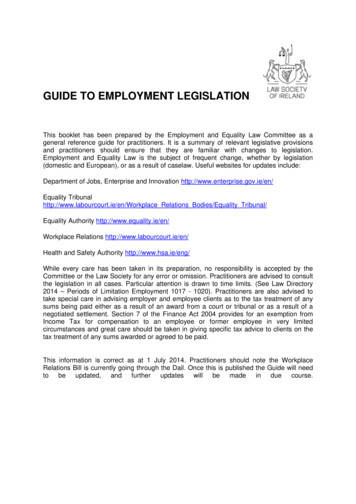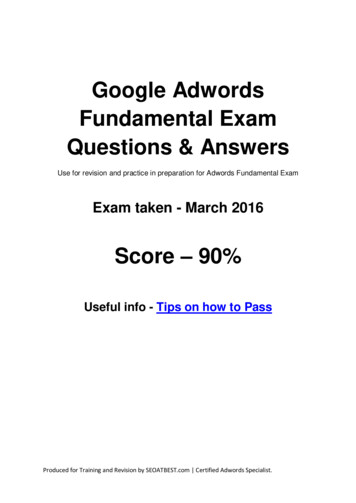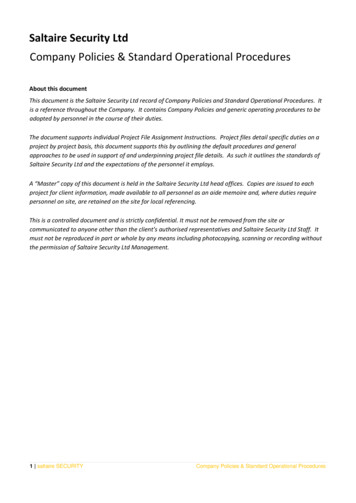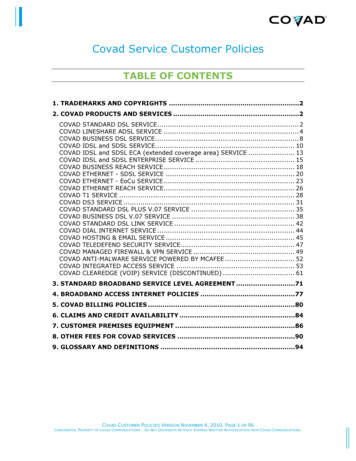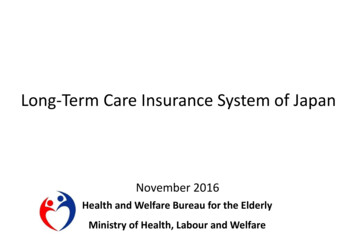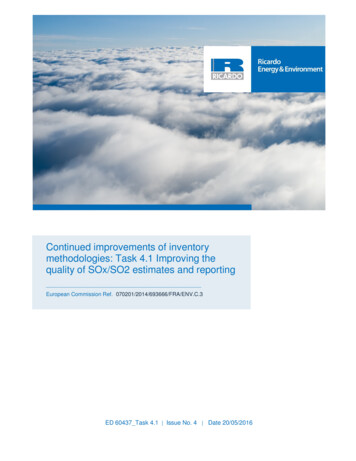
Transcription
Legislation and Policies forInclusive EducationWebinar 3- Companion Technical BookletLet’s decideT E AC HSCHOOL DIRECTORMINISTRY OFEDUCATIONER
United Nations Children’s Fund (UNICEF) 2014About the author: Gerison Lansdown was the founderdirector of the Children’s Rights Alliance for England,and is now an international children’s rights consultantand advocate who has published and lectured widelyon the subject of children’s rights. She was activelyinvolved in the negotiations for the Convention onthe Rights of Persons with Disabilities, is a seniorassociate of the International Institute for Child Rightsand Development in Victoria, and Chair of the Childto-Child Trust. She is on the editorial advisory boardof the Canadian Journal of Children’s Rights and wasformerly Vice Chair of UNICEF-UK.Permission is required to reproduce any part of thispublication. Permission will be freely granted toeducational or non-profit organizations. Others willbe requested to pay a small fee.Coordination: Paula Frederica HuntEditing: Stephen BoyleLayout: Camilla Thuve EtnanPlease contact: Division of Communication, UNICEF,Attn: Permissions, 3 United Nations Plaza, New York,NY 10017, USA, Tel: 1-212-326-7434;e-mail: nyhqdoc.permit@unicef.orgWith major thanks to Australian Aid for its strongsupport to UNICEF and its counterparts andpartners, who are committed to realizing the rightsof children and persons with disabilities. The Rights,Education and Protection partnership (REAP)is contributing to putting into action UNICEF’smandate to advocate for the protection of allchildren’s rights and expand opportunities to reachtheir full potential.
Webinar 3 - Companion Technical BookletLegislation and Policies for Inclusive EducationWebinar BookletWhat this booklet can do for you4Acronyms and Abbreviations6I. Understanding a Rights-Based Approach to Inclusive Education7II. Assessing the Country Context9III. Specific Legislation and Policies to Implement Inclusive Education12Access to and Availability of Inclusive Education . . . . . . . . . . . . . . . . . . . . . . . . . . . . . . . . . . . . . . . . . . . . . . . . . . . . . . . . . 12Removing the Attitudinal Barriers to Inclusive Education. . . . . . . . . . . . . . . . . . . . . . . . . . . . . . . . . . . . . . . . . . . . . . . . 17Respecting Identity, Culture and Language. . . . . . . . . . . . . . . . . . . . . . . . . . . . . . . . . . . . . . . . . . . . . . . . . . . . . . . . . . . . . . . . 20IV. Government-Wide Structures to Support Inclusive Education21Responsibility for the Education of all Children within the Education Ministry. . . . . . . . . . . . . . . . . . . . . . . 21Co-ordination of Policies across Governments. . . . . . . . . . . . . . . . . . . . . . . . . . . . . . . . . . . . . . . . . . . . . . . . . . . . . . . . . . . 23Devolved Government Structures. . . . . . . . . . . . . . . . . . . . . . . . . . . . . . . . . . . . . . . . . . . . . . . . . . . . . . . . . . . . . . . . . . . . . . . . . . . 27V. General Legislation and Policies to Support Inclusive Education29Ending Institutionalisation. . . . . . . . . . . . . . . . . . . . . . . . . . . . . . . . . . . . . . . . . . . . . . . . . . . . . . . . . . . . . . . . . . . . . . . . . . . . . . . . . . . . . . 29Guaranteeing the Right to Non-Discrimination. . . . . . . . . . . . . . . . . . . . . . . . . . . . . . . . . . . . . . . . . . . . . . . . . . . . . . . . . . . . 34Right to Respect for Personal and Physical Integrity . . . . . . . . . . . . . . . . . . . . . . . . . . . . . . . . . . . . . . . . . . . . . . . . . . . . 35Respect for Children’s Participation Rights. . . . . . . . . . . . . . . . . . . . . . . . . . . . . . . . . . . . . . . . . . . . . . . . . . . . . . . . . . . . . . . . . 38VI. Summary of Key Points41Endnotes423
Webinar 3 - Companion Technical BookletWhat this booklet can do for youThe purpose of this booklet and the accompanying webinar is to assist UNICEF staff and our partners tounderstand the laws and policies that need to be introduced in order to provide the necessary environmentfor inclusive education.In this booklet you will be introduced to: A rights-based approach to inclusive education. An overview of the broad measures across government needed to underpin inclusive education. The case for dedicated legislation and policies to introduce inclusive education. The barriers impeding access of children with disabilities to inclusive education. The measures needed to ensure respect for the rights of children with disabilities withineducation.Learning objectivesThis module will provide an overview of the legislation and policies, consistent with internationalhuman rights standards, that need to be adopted in order to create the necessary environmentin which it is possible to introduce and sustain the right to inclusive education for children withdisabilities. It will build on the rights-based framework that was described in the first module tothis series. The learning objectives are: To appreciate the overall focus of a rights-based approach to inclusive education. To describe the specific measures needed to create inclusive quality education. To understand the importance of government structures necessary to support inclusiveeducation. To describe the broad-based legislation and policy provisions needed to build the environmentfor inclusive education. To recognize the barriers impeding the right to inclusive education.For information on the following related topics, refer to the other modules in this series:1. Conceptualizing Inclusive Education and Contextualizing it within the UNICEF Mission2. Definition and Classification of Disability3. Legislation and Policies for Inclusive Education (this booklet)4. Collecting Data on Child Disability4
Webinar 3 - Companion Technical Booklet5. Mapping Children with Disabilities Out of School6. EMIS and Children with Disabilities7. Partnerships, Advocacy and Communication for Social Change8. Financing of Inclusive Education9. Inclusive Pre-School Programmes10. Access to School and the Learning Environment I – Physical, Information and Communication11. Access to School and the Learning Environment II – Universal Design for Learning12. Teachers, Inclusive, Child-Centred Teaching and Pedagogy13. Parents, Family and Community Participation in Inclusive Education14. Planning, Monitoring and EvaluationHow to use this bookletIn this booklet, you will find boxes elaborating key issues, case studies, additional readings and suggestedactivities to strengthen learning for action.If, at any time, you would like to go back to the beginning of this booklet, simply click on the sentence"Webinar 3 - Companion Technical Booklet" at the top of each page, and you will be directed to the Tableof Contents.To access the companionwebinar, just scan the QR code.SCHOOL5
Webinar 3 - Companion Technical BookletAcronyms and AbbreviationsCBRCommunity-Based RehabilitationCEE/CISCentral and Eastern Europe and Commonwealth of Independent StatesCRCConvention on the Rights of the ChildCRPDConvention on the Rights of Persons with DisabilitiesPSGsParent Support GroupsNGONon-Governmental O rganizationWASHWater, Sanitation, Hygiene6
Webinar 3 - Companion Technical BookletI. Understanding a Rights-Based Approachto Inclusive EducationA human rights-based approach to inclusive education requires an understanding of inclusion as anapproach to education for all children, based on the provisions of both the Convention on the Rights of theChild (CRC) and the Convention on the Rights of Persons with Disabilities (CRPD). It represents a profoundchange in the way most education systems are conceived, necessitating a commitment to creating systemsand schools which respond to the needs of individual children, rather than forcing children with differentlearning needs to comply with a rigid, pre-determined structure. In order to bring about such a change,investment is needed in a broad range of measures to remove the barriers which impede implementationof inclusive education and build the framework on which it can be sustained.In the previous booklet, you were introduced to a framework for understanding a rights-based approach toeducation. It is reproduced here in Figure One.Figure 1Commitment to the right of every child with a disability to inclusive education through legalreform, policy and guidance, service delivery, attitudinal and cultural change, respect for humanrights, training and support for teachers, and participatory engagement with children and families.qualityeducationaccesseducationRespect foreducationThe right to inclusive educationCross-departmental government structures; de-institutionalisation; data collection; financing;capacity building; participation and partnerships; transparency and accountability.In this framework, you will see that there are a number of ‘building blocks’ that need to be in place tosupport a rights-based approach to education for all children with disabilities. First, inclusive educationrequires a broad-based acknowledgement and commitment from government, drawing on theresponsibilities of many different government departments to realize it. Inclusive eduction involves theintroduction of a comprehensive foundation of legislation, policies, strategies, guidance and services to buildthe culture, environment and commitment necessary to remove the barriers to quality education for allchildren with disabilities. Building on such a framework, investment is then needed in specific measures forthe education system to address:7
Webinar 3 - Companion Technical Booklet The right of every child to education, together with a systematic approach to identifying andremoving the barriers and bottlenecks that impede access. The right to quality education that provides a relevant curriculum delivered through a pedagogywhich reflects the different ways in which children learn, and creates a learning space whichincludes rather than excludes children. The right to an education which is respectful of the cultural, protection and participation rightsof children in other words, an environment in which they are safe, their physical and emotionalintegrity respected and their voices heard and taken seriously.This booklet will focus on both the general and education-specific legislation and policies described in theframework.Together, the introduction of these measures will provide the infrastructure within which it is possible todevelop and sustain inclusive education for all children.For other areas of both government-wide and educationspecific policy necessary for supporting inclusive education,such as data collection, financing, partnerships, training,access to the learning environment and monitoring andevaluation, see the relevant booklets in the series.Notes8
Webinar 3 - Companion Technical BookletII. Assessing the Country ContextEvery country will be at a different stage of development in relation to appropriate legislation and policiesfor inclusive education, as well as in securing the necessary political will and attitudinal change. In addition,there are wide variations in how states have traditionally responded to children with disabilities and thesevariations will influence the measures that are needed to promote inclusive education. In recent years,there has been significant progress in many developed countries towards inclusive education, backed upby legislation, community-based services and specialized teaching support. However, a different pictureemerges in some regions, such as in Central and Eastern Europe and the Commonwealth of IndependentStates (CEE/CIS), where the context is one in which significant investment had been made in the creationof specialized institutions to care for children with disabilities. Most children with disabilities were expectedto be cared for in these institutions, and accordingly little or no development of community-basedsupport services existed. Efforts are now being made to unlock the financial resources embedded in theseinstitutions and to re-focus professional training towards inclusion and community-based care, but there isstill a long way to go before it will be possible to establish inclusive education.By contrast, in many developing countries there are few institutions or other forms of support, and familiesare left largely without support of any kind to help them care for children with disabilities. Very few havetraditionally provided an education of any kind for children with disabilities. In such contexts, therefore, itwill be necessary to invest in education and communication with families, communities, policy-makers andother key stakeholders to raise awareness that children with disabilities have both the right and the capacityto learn, as well as creating the basic infrastructure of inclusive education.Finally, in those countries facing conflict and humanitarian disasters, education and care systems forall children are often significantly destroyed or weakened. However, the reconstruction process, whensignificant resources are being invested, provides a real opportunity to build towards a more inclusiveapproach. It can sometimes be easier to establish inclusive education when starting a new system thanto unpick and re-design existing services. But this requires effort and advocacy. Often this opportunityto rebuild in an inclusive manner may be lost if adequate pressure is not brought to bear on differentstakeholders.Activity OneYou can use the following matrix to undertake a broad assessment of where progress in theintroduction of necessary legislation and policies, if any, has been made in your country. If possible,this process should be undertaken as a group activity involving all relevant stakeholders. Once youhave undertaken this assessment, it will help you identify the legislative and policy priorities for actionand which areas require action to move forward in promoting inclusive education.PLEASE NOTE: the criterion in each box of the matrix is there to provide indicative guidance ofprogress. Your country context may not match it precisely, but you can use it as a general guide.9
Webinar 3 - Companion Technical BookletLegislation andpolicies for IE1. Every childhas the right toeducation2. The schooland learningenvironment isaccessible3. Teachers,including teacherswith disabilities,are supported towork in inclusiveeducation settings4. Every childhas right toprotection fromdiscriminationon grounds ofdisability10Championing (Score 4)Established (Score 3)Initiating (Score 2)Weak (Score 1)There is a law/policyestablishing the right ofall children to receive aneducation in inclusivesettings, with an explicitmention of children withdisabilities. A common/general education sectorplan/policy is in place thatis inclusive of all children, inoutreach and practice, andaddresses issues of equity.There is a law/policyestablishing the right ofall children to receive aneducation, with an explicitmention of children withdisabilities. A separateinclusive education policy/plan is in place.There is a law/policyestablishing the rightof all children to attendschool, which implicitlybut does not explicitlyinclude children withdisabilities.No law/policyestablishing theright to educationfor children withdisabilities.Government invests inwidespread consultationwith disability community toidentify and remove physical,transport, communicationand attitudinal barriersimpeding the access ofchildren with disabilities toand within school. Policies,supported by resources,introduced to take action onthose barriers. All schoolshave accessible classroomsand/or reasonableaccommodations thatremove all communicationand physical barriers(including accessible toiletsand recreation areas).More than half ofschools have accessibleclassrooms and toilets,including throughcommunicationaccommodations.Government recognizesthe existence of multiplebarriers, and is takingaction on a case-by-casebasis, with no overallpolicy.Less than half of theschools are accessible(including toilets). Someschools may haveaccessible classrooms,or use makeshift ramps.No communicationaccommodations suchas provision of signing.Government recognizesneed to addressthe physical andcommunication barriersimpeding access toschool, including stairs,narrow doors andinaccessible transport.No overall policy orresources available toremove these barriers.No action on otherbarriers.Medical model ofdisability prevails.No investment inanalysis or removalof barriers impedingaccess to inclusiveeducation.The policy/plan oninclusive education includesrecommendations to preand in- service training toprepare teachers for inclusiveapproaches to education, andprovide on-going capacitydevelopment and support.Steps have been takento implement the policy.Government has madean explicit commitment torecruit and train teachers withdisabilities. Any legislativebarriers to their recruitmenthave been removed.Investment made in trainingcolleges to promote andsupport access.The policy/plan oninclusive educationincludes recommendationsto pre- and in- servicetraining to prepareteachers for inclusiveapproaches to education.Government has madean explicit commitmentin principle to recruitand train teachers withdisabilities. Policies tosupport their recruitmentnot yet implemented.Government isdeveloping proposalsfor training to supportinclusive education.Government willing torecruit teachers withdisabilities. No proactiveinvestment to enablethis to happen.No plans are in placeto provide teacherswith training oninclusive approachesto education.No teachers withdisabilities are inplace in schools.No policies orcommitment torecruit them.Non-discrimination ongrounds of disability isin both constitution andlegislation, backed up byclear policies, and strategiesto promote implementationand provide mechanisms forenforcement.Legislation is in placeto guarantee nondiscrimination on groundsof disability but noaction taken to ensureimplementation.General discriminationlaw is in place but nospecific reference todisability – includedunder ‘or other status’ orequivalent.No protection fromdiscrimination existsin legislation or theconstitution.
Webinar 3 - Companion Technical BookletLegislation andpolicies for IEChampioning (Score 4)Established (Score 3)Initiating (Score 2)Weak (Score 1)Legislation bans all formsof corporal or otherhumiliating punishmentin all schools. Legislationis widely promoted andteachers trained in positiveforms of discipline. Schoolsare required to have antibullying strategies that takefull account of the particularvulnerability of children withdisabilities to violence, and togender-based dimensions ofviolence.Legislation bans all formsof corporal punishment inschools, but little supportis provided to teachers toensure its implementation.Children are largelyunaware of the legislation.Government policydiscourages use ofcorporal punishmentbut it is not prohibited.No legislationbanning corporalpunishment inschools, and nopolicies on bullying.There are mandatorystudent councils and schoolmanagement committeeswhere students have realcontrol over importantdecisions. Student councilsare fully representative of thestudent body, and childrenwith disabilities play an activepart. Government consultschildren with disabilities onhow to strengthen inclusiveeducation.Student councils arewidespread in mainstreamschools, but only in afew special schools. Ininclusive schools, childrenwith disabilities tend to beexcluded from participationin school councils.There are studentcouncils in a fewmainstream schools,but no opportunitiesat all for the voices ofchildren with disabilitiesto be heard.There are no studentcouncils or othermechanisms in anyschools throughwhich children canvoice their views.The ministry of education isresponsible for the educationof every child, and has explicitpolicies in place to reach outto all children with disabilitiesto ensure that they are inschool.Education for children withdisabilities does rest witheducation ministry but ithas limited resources and/or commitment, and manychildren with disabilitiesremain out of school.Government isproposing to transferresponsibility foreducation of childrenwith disabilities to theeducation ministry butthere is no deadline inplace.Responsibility forall matters affectingchildren withdisabilities restswith the ministry ofhealth, social welfareor equivalent.8. A governmentwide andcoordinatedapproach toinclusive educationis in placeA clear government-widepolicy for inclusive educationis in place involving ministriesof education, social welfare,child protection, health,transport, planning, water andsanitation, finance, etc.A government-wide policyfor inclusive education isin place but only limitedprogress is made in itsimplementation.Some collaborationexists between keydepartments but it is adhoc and informal.No co-ordinationexists betweengovernmentdepartments.9. Children withdisabilities arecared for andsupported withintheir families orsubstitute familyenvironmentChildren with disabilitiesare supported throughcommunity-based supportservices to live with theirfamilies. A time-framednational strategy, backed upby legislation, is in place toclose down any existing largeinstitutions caring for childrenwith disabilities and transferresources to mainstreameducation and inclusivecommunity-based services.Government is committedto ending institutional carebut no national strategy isin place. Action happeningon a piecemeal basis only.Some financial provisionand services to supportfamilies of children withdisabilities living at homehave been introduced.Governmentacknowledges thedetrimental impactof institutional carefor children and plansto move towardstheir closure, but noimplementation to date.Limited support only forfamilies of children withdisabilities.Children withdisabilities arecommonly placedin institutions andno action is beingtaken to limitthe numbers ininstitutional care. Nocommunity-basedsupport servicesexist for familieswith children withdisabilities.5. Children areprotected from allforms of violencein schools6. Children have aright to democraticparticipation inschools and tobe consulted oneducation policy7. Access toeducation forchildren withdisabilities is theresponsibility ofeducation ministry11
Webinar 3 - Companion Technical BookletIII. Specific Legislation and Policies toImplement Inclusive EducationAccess to and Availability of Inclusive EducationArticle 24 of the CRPD, as well as Article 28 of the CRC, asserts the right to education on the basis ofequality of opportunity for every child. The CRPD also emphasizes that this must be provided in inclusivesystems at all levels. It explicitly requires that children with disabilities are not excluded from the generaleducation system on the basis of disability. They are entitled to inclusive, free and quality education on anequal basis with others in the communities in which they live. The Committee on the Rights of Personswith Disabilities has stressed that “.it is the entire process of inclusive education that must be accessible,not just buildings, but all information and communication, including ambient or frequency modulationassistive systems, support services and reasonable accommodation in schools. The whole environmentof students with disabilities must be designed in a way that fosters inclusion and guarantees their equalityin the entire process of their education.”1 Inclusion needs to be understood as integral to the whole of theeducation system – not just an add-on.Inclusive education needs to be seen as one part of the wider goal of making society more just and lessdiscriminatory for all marginalized populations through education delivery. It is not simply a technicalor organizational change, but involves a cultural and philosophical change of approach based on acommitment to respect for every child, and recognition of the obligations of the education system toadapt to accommodate and address her or his needs and rights. Consequently, legislation across all publicsectors should lead to the provision of services that enhance developments and processes working towardsinclusion in education.In addition, the commitment to inclusive education must be elaborated in detail in legislation so thatobligations and accountability are explicit. This will support government at the national and local levels towork towards a common approach and be held accountable for ensuring its implementation for every child.Thus, for example, provisions such as special education laws that establish separation among studentswith and without disabilities need to be reviewed. Similarly, day-care centres and other settings createdto provide rehabilitative services exclusively to children with disabilities, and which place an inappropriateemphasis on ‘changing the child’ rather than creating an adaptive and inclusive education system, willneed revision. Additional policy changes might be required to policies relating to, for example, enrolment,curriculum, assessment, school governance human resources quality assurance, self-evaluation, externalevaluation, and inspection regimes.12
Webinar 3 - Companion Technical BookletDevelopments in legislative and policy reformSouth Africa2With the introduction of the policy on Inclusive Education, as published in Education White Paper6 of 2001, the Department of Education made a commitment to ensure that all children would bewelcomed in all schools and that they would be supported to develop their full potential irrespectiveof their background, culture, abilities or disabilities, their gender or their race. The concept ‘full-service/inclusive school’ was introduced to show how ordinary schools could transform themselves tobecome fully inclusive centres of care and support.It is intended that by 2021, 500 primary schools will have been converted to become inclusive,special schools will be converted into resource centres, and circuit-based and district-based supportteams will be established. To date, 30 districts have support teams, teacher training and workshopshave been provided, 30 schools have been provided with assistive devices and 10 mainstreamschools have been upgraded into model schools. One of the success factors was the learning fromthe past that inclusiveness in society is the only way of living peacefully together.Thailand3The Government of Thailand undertook extensive international research on good practice in inclusiveeducation internationally. As a result it committed to a policy framework mandating inclusion ofchildren with disabilities in mainstream schools. The policy seeks to raise awareness of the right toeducation for all children with disabilities and to introduce a clear mandate throughout the schoolsystem for marginalised children. It introduced a National Special Education Plan, and a NationalEducation Act which protected the rights of people with disabilities including the right to education under the constitution, followed by a new policy stating that persons with disabilities must be providedwith education opportunities to improve their lives. Its effectiveness to date has been achievedthrough a process of combining promising international practices with local values and priorities.13
Webinar 3 - Companion Technical BookletThe challenge of maintaining progress4In 2005, the Vietnamese Government approved the country’s new education law stating that learningis the right and obligation of every citizen and that every citizen has equal rights of access to learningopportunities. In addition, compulsory education includes both primary and lower-secondary levelsand priority in resource allocation for teachers, infrastructure, equipment and budget was to begiven to schools and classes that supported the learning of students with disabilities.5 As a result ofthis policy, survey data from the Ministry of Education and Training in 2005 reported 32 per centof 700,000 primary-school-age children with disabilities attended classes in ‘regular’ schools, asignificant advancement given that only 10 years previously therewas only one lower-secondary school able to accept students with disabilities.However, Viet Nam continues to face educational challenges such as inequity, teacher recruitment,quality instruction and small budgets. Consequently, inclusive education is often viewed as anadditional burden. After initial progress, UNESCO-IBE data indicates that Viet Nam is movingbackwards, with only an estimated 10 per cent of its 1 million students with disabilities receivingschooling at all in 2007-08.6 In order to help strengthen its commitment to inclusive education,a collaborative approach is being adopted. The National Institute for Educational Strategy andCurriculum Development, a task group made up of representatives from ministries, communities,NGOs, research, and professional service providers is focusing on the measures needed to makeinclusive education a sustained reality. It will address policy, including school organization, parent andcommunity partnerships, and professional development, for those who will deliver instructional andspecial education-related services such as diagnostic, therapy and speech services, and programmedevelopment and leadership within the schools.An integrated legal and policy framework covering inclusive education should address all educationalsectors and levels. It needs to be comprehensive, coordinated and comprehensively address issues offlexibility, diversity and equity in all educational institutions for all learners. Key elements to be addressedare that its provisions:14 Comply with international human rights standards – in particular the CRC and CRPD. Include a clear definition of inclusion and the specific objectives it is seeking to achieve. Inclusionprinciples and practices need to be considered as integral to reform, and not simply an add-onprogramme. Provisions, for example, which de
What this booklet can do for you. The purpose of this booklet and the accompanying webinar is to assist UNICEF staff and our partners to understand the laws and policies that need to be introduced in order to provide the necessary environment . for inclusive education. In t



